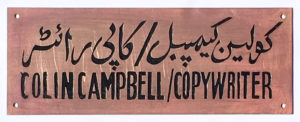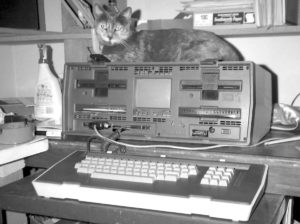I’ve styled myself as “Colin Campbell, Copywriter” since the 1970s. My travel-writer pal Jerry Dunn had this made for me at a bazaar in India in the 1980s:

The Arabic is supposedly a phonetic transcription of “Colin Campbell, Copywriter,” although it could say “Go home, yankee vermin,” for all I know.
I’ve been a copywriter for forty years and I’ve been writing a daily journal about copywriting all this time and now I’m going to start doing it in public to explore what “copywriting” means today.
The word entered the language about a hundred years ago. Wiki tells me the first copywriter was a guy named John Emory Powers (1837-1919). He worked for department stores before going freelance in 1886 at age 49:
At a time when most advertisements featured hyperbole, Powers became noted for his focus on facts. He refused to write copy for a product unless he was convinced of its merits. He once stated that the most important thing in advertising is getting the attention of the reader by being interesting, and the next most important thing is to stick to the truth: “that means rectifying whatever’s wrong in the merchant’s business. If the truth isn’t tellable, fix it so it is.”
Until today I’d never heard of John Emory Powers. I like it that he was a stickler for facts. That’s the way I’ve always written copy: talk truth about the product, and people will believe it.
My first job out of college was as a production assistant at an in-house advertising office that created newspaper ads for all the Sears stores in southeastern Michigan.
It was the hot-metal era of newspaper production. The text was set in molten lead by a linotype operator on an ETAOIN SHRDLU keyboard. Pictures had to be printed using zinc plates etched with a reverse version of the image. I became expert at writing copy with the precise number of words that fit exactly into the rigid metal layout.
Later in my career when I was up against a deadline and didn’t know what to do, I would tell myself to fall back into the arms of Mother Sears and produce a clear plain description of what was being offered for sale.
In 1976 I became Associate Editor at Santa Barbara Magazine. The magazine offered a free copywriting service to advertisers. I was the free copywriter, besides writing and editing articles. Some of the advertisers hired me to write other ads and brochures. My freelance work expanded.
I took a full-time job as a copywriter at BBDO Detroit on the Dodge account and wrote radio, TV, newspaper and magazine ads. I was making the same money as Tigers’ rookie shortstop Alan Trammel. The first thing I bought was an IBM Correcting Selectric typewriter. I’ve been a typewriter keyboard addict all my life and that was the apex typewriter available in the world.
When the ad agency lost the Dodge account and fired everybody, I realized I preferred working for smaller companies instead of seeking approval through an infinite series of committee decisions. I went back to the West Coast and I’ve been a freelancer/contractor ever since.
I wrote a recruitment brochure for the Computer & Electrical Engineering department at UC Santa Barbara and used my check from that job to buy my first computer, an Osborne 1 with a massive 5″ monitor. It ran the CP/M operating system. The Felis heat absorption device was an after-market attachment.

Five years later I bought my first Macintosh along with a LaserWriter Plus and my career veered over into graphic production. I was able to supply my clients with camera-ready text and photos for their ads, flyers, and brochures.
I bought a modem and became enmeshed in the fledgling Bulletin Board System (BBS) in Santa Barbara. I was editor and publisher of the newsletter for the Santa Barbara Macintosh Users group, and I published one of the first on-line magazines showcasing the fiction of young writers.
I began attending hacker conventions. I moved to the Bay Area and did graphic production as a Quark/Illustrator/Photoshop jockey as the dot.com boom ramped up. I wrote for the Internet Shopping Network, and completed 17 contracts writing for Wal-Mart.com, at the same time that I was webmaster for a home-improvement technology company.
Now the winds of time have left me semi-retired on the Central Coast of California. I’m looking around at industrial and technology sites and I see that they are not written with the basic precepts of copywriting in mind. I can help these companies a lot. So I’m going to illustrate what I mean by copywriting by discussing some of my projects from the past.